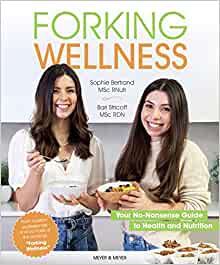What Is Intuitive Eating?
If restrictive diets have done you no favours, it might be time to consider the more holistic approach of intuitive eating

When you’re deciding what to eat, what are you thinking about? Is it what you’ll actually enjoy eating? Or are you mostly concerned about how what you choose will help you lose weight or fit with a certain diet you’re attempting to follow?
The question of enjoyment is one of the first you should ask yourself if you’re considering adopting the intuitive eating approach, which rejects diets and diet culture, seeing it as counterproductive.
There’s a lot more to intuitive eating than asking that question, though, so we enlisted registered nutritionist Sophie Bertrand for more information.
Intuitive eating is one of the topics covered in the new book Forking Wellness, written by Bertrand and dietitian Bari Stricoff, which tries to demystify and simplify nutrition, as well supplying a buffet of healthy recipes to try.

Forking Wellness: Your No-Nonsense Guide to Health and Nutrition
What is intuitive eating?
It’s a non-diet approach and it has the intention of helping individuals heal from chronic dieting. If you’ve lived your whole life restricting, overeating and yo-yo dieting, then intuitive eating can be a really helpful approach to establishing a more “normal” relationship with food again.
Get the Coach Newsletter
Sign up for workout ideas, training advice, reviews of the latest gear and more.
Intuitive eating has been associated with loads of benefits, like improved body image, improved metabolism, reduced levels of anxieties around food, and weight maintenance. If you’re going on and off diets your whole life, you’re never really sitting at a comfortable weight.
Why is it helpful to stop dieting?
Diets come with so many rules and side effects – things like slow metabolism, disordered eating behaviours, and feelings of guilt and anxiety around food. When you have an unhappy relationship with food it can make your entire day and your entire life miserable. So using a non-diet approach takes away those rules and restrictions around food and helps you work out what foods you really enjoy, what foods make your body feel good and energised, without having weight as the focus.
Diets don’t work. You can ask anyone who’s been on a diet and they’ve been unable to maintain that diet. Usually when you stop the diet, because it’s unsustainable, you will put the weight back on that you’ve lost – often plus more, because you’ve damaged your metabolism.
There’s no really good long-term outcome from going on diets. The intuitive eating approach is about taking the focus away from weight and putting it on your long-term health.
How can you start with intuitive eating?
It’s not something that can be done overnight, especially if you’ve been dieting for some years. You will have built up a certain relationship with food and to undo that takes some time. So intuitive eating is made up of ten principles and they can be worked through in whatever order you see fit. It is best done with an intuitive eating professional, but if that’s not realistic there are lots of resources online and books to read.
Before you start with the ten principles, our book has a helpful bit covering things you can do first. Take a step back and ask why you want to change your relationship with food, what you want to get out of it.
Our first tip would be to start thinking about your food choices and what’s actually driving them. Is it a voice in your head saying “you’re on a diet, you need to lose weight, you need to go for the low-calorie option”? Or is it you saying “I really like this food and feel really good when I eat it, so that’s what I’m going to choose”? Get to the bottom of why you’re eating what you’re eating, and ask if you’re enjoying what you’re eating.
How can you find reliable information about intuitive eating online?
A red flag would be if any intuitive eating approach suggests you will lose weight by using it. Weight is not something that’s talked about with intuitive eating – we put the whole focus on your health and wellbeing. So if anyone is trying to sell you a non-diet approach that also promises weight loss, the person talking probably isn’t qualified to talk about intuitive eating.
See related
- 6 Ways To Improve Your Body Confidence That Aren’t Exercise
- How to Stop Loving Fries (and Reboot Your Relationship with Food)
What if I always think I want chocolate when choosing my food?
A lot of people are fearful that if they do give in and have what they genuinely want, they will lose control. If I said to you, “For the next five days all you can eat is your favourite chocolate bar” you probably would be like, “That sounds terrible, I’m going to feel like rubbish because I haven’t got any vegetables in my diet.”
When you actually put it in perspective and say, “Go ahead eat what you want”, people don’t feel good indulging themselves. They don’t feel good not eating vegetables, or protein and carbohydrates and essential fats. We need a balance, and people are often pleasantly surprised to find that they crave that balance, once they take the rules away and let themselves experiment with food a bit more.
How long will it take to become an intuitive eater?
The good thing is that once you start with the approach and work your way through the ten principles, you can see changes quite quickly. However, to master intuitive eating could take anything from a few months to years, depending on how long you have been dieting before. But you can see positive changes much quicker if you commit to not dieting any more.
Do you find people still explore new recipes and foods when intuitive eating?
Absolutely. We’re trying to encourage diversity in the diet and experimenting with new foods to figure out what feels good for you. You might have an obsession with pasta for a while, but there’s only so much pasta you can eat and you’re going to want to seek out new recipes at some point.
Buy Forking Wellness from Waterstones | Buy Forking Wellness from Foyles

Forking Wellness: Your No-Nonsense Guide to Health and Nutrition

Nick Harris-Fry is a journalist who has been covering health and fitness since 2015. Nick is an avid runner, covering 70-110km a week, which gives him ample opportunity to test a wide range of running shoes and running gear. He is also the chief tester for fitness trackers and running watches, treadmills and exercise bikes, and workout headphones.
